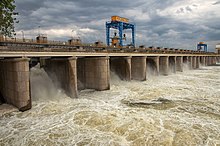
The Dnieper, also called Dnipro, is one of the major transboundary rivers of Europe, rising in the Valdai Hills near Smolensk, Russia, before flowing through Belarus and Ukraine to the Black Sea. It is the longest river of Ukraine and Belarus and the fourth-longest river in Europe, after the Volga, Danube, and Ural rivers. It is approximately 2,200 km (1,400 mi) long, with a drainage basin of 504,000 square kilometres (195,000 sq mi).
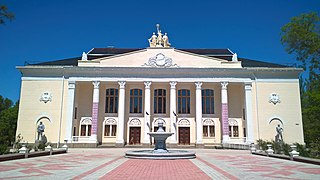
Nova Kakhovka is a city in Kakhovka Raion, Kherson Oblast, southern Ukraine. Nova Kakhovka has been under Russian occupation since February 2022. Its estimated population in 2022 was 44,427.

Kherson Oblast, also known as Khersonshchyna, is an oblast (province) in southern Ukraine. It is located just north of Crimea. Its administrative center is Kherson, on the west bank of the Dnieper which bisects the oblast. The area of the region is 28,461 km2 and the population 1,001,598. It is considered the 'fruit basket' of the country, as much of its agricultural production is dispersed throughout the country, with production peaking during the summer months.
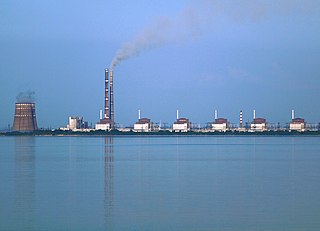
The Zaporizhzhia Nuclear Power Station in southeastern Ukraine is the largest nuclear power plant in Europe and among the 10 largest in the world. It has been under Russian occupation since 2022. It was built by the Soviet Union near the city of Enerhodar, on the southern shore of the Kakhovka Reservoir on the Dnieper river. It is operated by Energoatom, who also operate Ukraine's other three nuclear power stations.

The Dnieper Hydroelectric Station ; also known as Dnipro Dam, in the city of Zaporizhzhia, Ukraine, is the largest hydroelectric power station on the Dnieper river. It is the fifth step of the Dnieper cascade of hydroelectric stations that provides electric power for the Donets–Kryvyi Rih Industrial region. The Dnieper Reservoir stretches 129 kilometres (80 mi) upstream to near Dnipro city.

The Kyiv Cistern, locally the Kyiv Sea, is a large water reservoir located on the Dnieper River in Ukraine. Named after the city of Kyiv, which lies to the south, it covers an area of 922 square kilometres (356 sq mi) within the Kyiv Oblast. The reservoir filled in 1964–1966 after the dam for the Kyiv Hydroelectric Power Plant was built at Vyshhorod. The reservoir is mainly used for hydroelectricity generation, industrial and public consumption, and irrigation.

The Kakhovka Reservoir was a water reservoir on the Dnieper River in Ukraine. It was created in 1956, when the Kakhovka Hydroelectric Power Plant was built at Nova Kakhovka.

The Dnieper reservoir cascade or Dnieper cascade of hydroelectric power stations is a series of dams, reservoirs and hydroelectric power stations on the Dnieper river in Ukraine. It was created to prevent uncontrolled flooding and improve water transportation infrastructure. Coordination and operation of all dams on the Dnieper is conducted by government company Ukrhydroenergo. In 1970, the Kyiv dam partially prevented flooding in comparison with the 1931 Kyiv flooding.

The Dnieper Reservoir is a water reservoir on the Dnieper river in Ukraine that was created by construction of the Dnieper Hydroelectric Station at Zaporizhzhia in 1932. The filling of the reservoir inundated the Dnieper Rapids. It is one of several reservoirs in the Dnieper reservoir cascade.
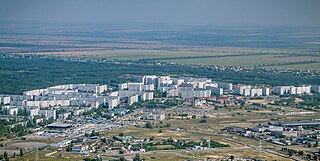
Enerhodar is a city and municipality in the northwest of Zaporizhzhia Oblast, Ukraine. It is on the south bank of the Dnieper River, on the opposite side of the Kakhovka Reservoir from Nikopol and Chervonohryhorivka. Its main industry is electricity generation, at a coal-fired power station and a large nuclear power station. It has an estimated population of 52,237, about 11,000 of whom work at the nuclear power station.

The Inhulets is a river, a right tributary of the Dnieper, that flows through Ukraine. It has a length of 557 kilometres (346 mi) and a drainage basin of 14,460 square kilometres (5,580 sq mi).

The North Crimean Canal is a land improvement canal for irrigation and watering of Kherson Oblast in southern Ukraine and the Crimean Peninsula. The canal has multiple branches throughout Kherson Oblast and Crimea.
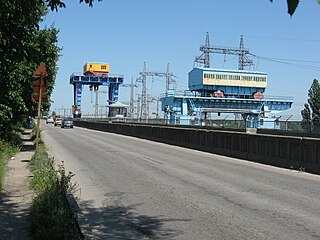
The Kremenchuk Hydroelectric Power Plant is a run-of-river power plant on the Dnieper River just upstream of Kremenchuk in Svitlovodsk, Ukraine. The primary purpose of the dam is hydroelectric power generation and navigation. It is the third dam in the Dnieper cascade and creates the largest reservoir on the river. The dam has an associated lock and a power station with an installed capacity of 624 megawatts (837,000 hp). Construction on the dam began in May 1954, the reservoir began to fill in October 1959, the last generator was commissioned in 1960 and the dam and power plant were inaugurated in 1961. It is operated by Ukrhydroenergo.
Novovorontsovka is an urban-type settlement in Beryslav Raion, Kherson Oblast, southern Ukraine. It hosts the administration of Novovorontsovka settlement hromada, one of the hromadas of Ukraine. Novovorontsovka is located on the right bank of the Kakhovka Reservoir, an artificial reservoir on the Dnieper. It has a population of 5,951.
Kozatske is an urban-type settlement in Kakhovka Raion, Kherson Oblast, southern Ukraine. It is located on the right bank of the Dnieper, separated from Nova Kakhovka on the left bank by the dam of the Kakhovka Hydroelectric Power Plant. Kozatske belongs to Nova Kakhovka urban hromada, one of the hromadas of Ukraine. It has a population of 3,653.

The southern Ukraine campaign is an ongoing theatre of operation in the Russian invasion of Ukraine, which began on 24 February 2022. From their base in Russian-occupied Crimea, the Russian Armed Forces attacked Kherson Oblast, Mykolaiv Oblast, and Zaporizhzhia Oblast in southern Ukraine, battling the Armed Forces of Ukraine.
During the Russian invasion of Ukraine, Russia occupied vast portions of the territory of Ukraine, having already occupied parts of the Donetsk and Luhansk oblasts as well as the entire Autonomous Republic of Crimea since the beginning of the Russia-Ukraine war in 2014. Partisan groups began to be organized in mid-2022. These groups have been involved in intelligence-gathering, sabotage, and assassinations. Much of their activity has taken place in the Kherson and Zaporizhzhia regions.
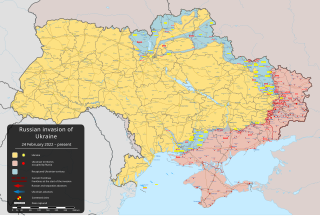
A military counteroffensive was launched by Ukraine on 29 August 2022 to expel Russian forces occupying the southern regions of Kherson and Mykolaiv oblasts.

During the Russian invasion of Ukraine, the Zaporizhzhia Nuclear Power Plant has become the center of an ongoing nuclear safety crisis, described by Ukraine as an act of nuclear terrorism by Russia.

On 6 June 2023, the Kakhovka Dam in Ukraine was breached, causing extensive flooding. Located on the Dnieper River in Kherson Oblast, the dam was under the control of the Russian military, which had seized it in the early days of the Russian invasion of Ukraine. Russian authorities blamed the dam breach on Ukrainian shelling. Ukraine and its allies accused Russian forces of blowing up the dam to hinder a planned Ukrainian counter-offensive.
